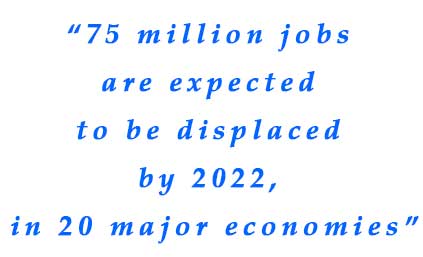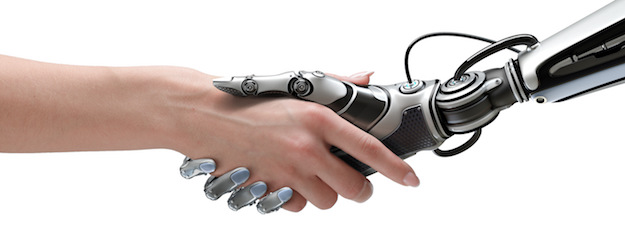The Middle Manager, for the last hundred years, was the backbone of most Companies and Corporations.
In our times, when 50% of the CEOs last under two years in their job, the Middle Managers stay, at their posts, should be strengthened. It is not always so.
According to the 2018 Future of Jobs Report, 75 million jobs are expected to be displaced by 2022, in 20 major economies. Many of those are Middle Management jobs.
The recent advances in Business digitalization and the resulting changes of Business Models have put these posts and the associated jobs under scrutiny.
 This comes on top of the ongoing paring down of the Management structure, which is a beloved issue of big Consulting Organizations and their Clients.
This comes on top of the ongoing paring down of the Management structure, which is a beloved issue of big Consulting Organizations and their Clients.
Nowadays, many middle management positions come often under critical review with a bias towards their elimination.
The principal reasons given are the holy words, efficiency, cost cutting, etc. which have been associated with slogans like “lean and mean”, and terms like “streamlining” “downsizing” and most of all “restructuring”.
It is difficult to understand that restructuring a Corporation or a Company is not an one-off activity like spring cleaning but an on-going process.
However, it often happens that an external Consultant is called in, with an express mandate to reduce the management quota. Since the Consultant is invited by the top managers, it is in the middle Management that the Consultant’s attention is focused.
Before judging this operation, a review of the basics of middle management is useful.
A Middle Manager is there to ensure that the current business is conducted as efficiently as possible.
The conduct of current business is the principal part of a Middle Manager’s job description.
Middle Managers ensure that business is organized and orchestrated, following current approved processes.
There is where the problem lies in our times of disruption. The current way of doing business becomes much faster obsolete than before. Innovation in business is now continuous.
The Middle Manager’s job is not primarily to innovate but to make sure that his/her departments deliver whatever is expected of it.
Additionally, current management practices ensure, in most of the cases, that the Middle Manager is not allowed to drastically change business procedures and practices.
This, imposed but unchallenged business routine leads to a Middle Manager’s complacency.
Hence, a Middle Manager is considered stolid, unimaginative and so on with worse terms being used as a reactionary, “…the middle management permafrost…” etc.
When a new process is introduced, usually top down, as for example recently digitalization or AI applications, the Middle Management is expected to immediately adjust to it.
It is often conveniently forgotten that the Middle Manager heads a team of people, that it is necessary to retrain and readjust, not only individually but, most importantly, as a team.
As a result, the “quick and dirty” solution is often to replace the Middle Manager with a  new one more “dynamic” and “up to date”.
new one more “dynamic” and “up to date”.
The replacement is naturally given time to adjust.
The time that is not given to the current Middle Manager, is given to its replacement.
As business is disrupted and changes, within a much shorter time than before, the shelf life of the Middle Manager is considerably reduced.
Eliminating the Middle Manager creates a false sense of economy that does not allow the cost of the learning curve of the new team to be factored in.
Replacing the Middle Manager is a bet that when evaluated overall, does not deliver the gains expected.
That, of course, is an ex post facto ascertainment.
As things stand now, executives become, faster than before, obsolete.
The rise of algorithms, artificial intelligence/machine learning, robotic process automation, and other, technologies are transforming completely the ways and dimensions in which business is conducted but it is also driving enormous changes in the workforce, particularly Managers.
The buzz word BEFORE, for eliminating Middle Managers was “over fifty”.
The buzz word NOW, for eliminating Middle Managers is “not current in Technology”.
If this appears unfair, it should be reminded here that an executive should expect a salary from the employing Company, not fairness.
The survival of the Middle Manager
A Middle Manager to survive and advance must change his/her approach to the business tasks. The ability to understand what tech can do for a department is a survival skill.
What a Middle Manager needs to apply to survive and thrive is a modified version of a simple principle that Google co-founder Sergey Brin thought up.
The 70/20/10 Principle
The idea Brin came up with is known as the 70/20/10 Rule. Meaning, if a company wants to blaze trails in its industry when it comes to novel ideas and products, it should invest 70 percent of its financial resources and manpower into the products already working well, 20 percent on newer ideas that are “low-hanging fruit“, and 10 percent on wild, outlandish bets.
This is ok for the C-suite but it must be modified for Middle Managers.

That means devoting 75% of his/hers and the team resources, in conducting, in the best way possible, current business.
Devote 24% of, mostly, his/her resources, in finding out and evaluating what are the real innovations and advances in his/her line of work and check shrewdly which ones are showing solid practical value. This is achieved by being continuously in contact with the market and the colleagues doing similar tasks.
Concentrate on those and try to “sell” the idea of adopting these new technologies and procedures to the top management of the Company.
This proactive approach, engages the top management into the Middle Management ideas instead of the opposite. In doing so the Middle Manager is in control much more vs when the new technologies and procedures are selected by the top management.
The remaining 1% is the odd bet for high gains. It is unlikely to happen but if it does it can propel the Middle Manager to Top Management.
The reason for the odd bet is that in few years’ time, the majority of Global 2000 companies and a significant number of the rest will have adopted a flexible, intelligent, collaborative virtual-physical work environment.
It has been proven that optimum results are achieved when technology and humans are in smooth cooperation. The need for sophisticated and automated workforce management is continuously and rapidly increasing. Therefore, the development of an intelligent and efficient marriage between Managers and technologies is inevitable.
 The Middle Manager is in the ideal position to ensure this.
The Middle Manager is in the ideal position to ensure this.
When the Middle Manager becomes part of the solution, the problem of this Managerial position is solved.

